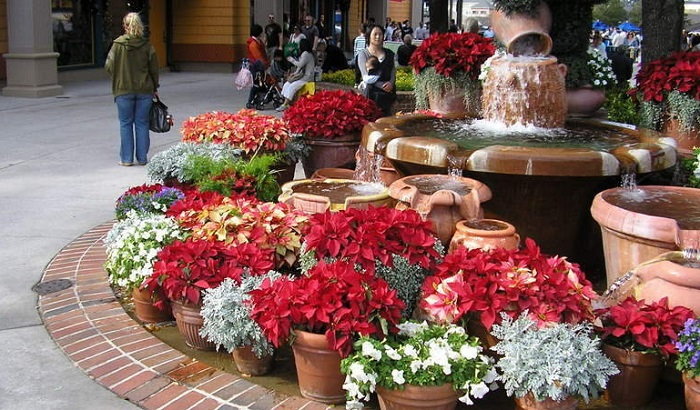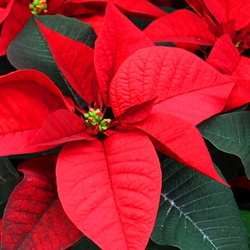My poinsettias have been sitting in my conservatory window all winter long, with their beautiful colored bracts showing off to all who were passing by on our street. I usually keep them until their cup-like flowers bloom and the bracts start to fade. Sometimes the fruits are already formed. This year they've bloomed later and the bracts were still there at the beginning of March, healthy and as beautiful as ever. However, since their flowers were opened and the nectar glands were full, it wouldn't have been long until the bracts would have faded. So I trimmed them back and moved them away from the window for a few months, until June. Then, I will move them closer to a sunny window for a better growth, and I will pinch their tips every two weeks, to make them bushier.
Pruning poinsettia is not like any other pruning because poinsettia is a Euphorbia (the Latin name is Euphorbia pulcherrima) and has a white sap (also called latex) which oozes from the cut. This might be toxic to some individuals and could cause irritations to the skin or eyes, so it's best to avoid contact. I am allergic to some chemicals, especially to detergent, but the poinsettia sap doesn't irritate my skin. Although I try to avoid contact, almost every time I prune poinsettias, I get "dirty" with white sap on my hands. It doesn't feel bad, only sticky and it cleans off with water and soap. Although the latex stops leaking and seals itself on the cut, even a few drops leaking out might damage the plant, especially when it's severely pruned. Poinsettia's white sap keeps the moisture inside the plant and carries the nutrients from the roots to all branches and leaves, like any other sap. If only a small part of it leaks out, then some parts of the plant might not get "fed" and die. When I'm pruning my poinsettias, I use a small sponge which I dip in a glass of warm water to stop the sap "bleed" from the cut. I just press the wet sponge onto the cut for a few seconds and the white sap stops oozing. Another drop of latex might come out from the cut afterwards, but this is good because it will congeal after few minutes in the air and seal the cut, protecting the plant from pests and illnesses.

If I want to save the cuttings and plant them later, I introduce them in a glass of warm water immediately to stop the white sap "bleed". It is more important to seal the cuttings when I want to start new plants and, even more if I want to use poinsettias as cut flowers. The white sap can be easily seared also with a flame - like the one of a lighter or a candle. Just keep the end of the stem above the flame for 5 seconds. I use the same sponge and warm water for stopping the latex oozing when pinching poinsettias, after they start new branches. I always keep them short, but bushy. Right now my poinsettias are ugly, but soon new sprouts will appear and they will grow in no time, turning into strong, bushy plants. I should keep them outside during summer, but the strong winds we have here can produce damage to the leaves. Any damage, even a small scratch, can produce sap leaking on a poinsettia leaf. That's why it's best to keep them inside. They grow well in a sunny window, but not in full sun, especially during the hot summer days. If kept outside, sun doesn't seem to damage their leaves, no matter how hot it is. After all, they are tropical plants, native to Mexico - the famous Flor de Noche Buena, meaning the Christmas Eve flower.
Images courtesy of Melody Rose and PlantFiles

















